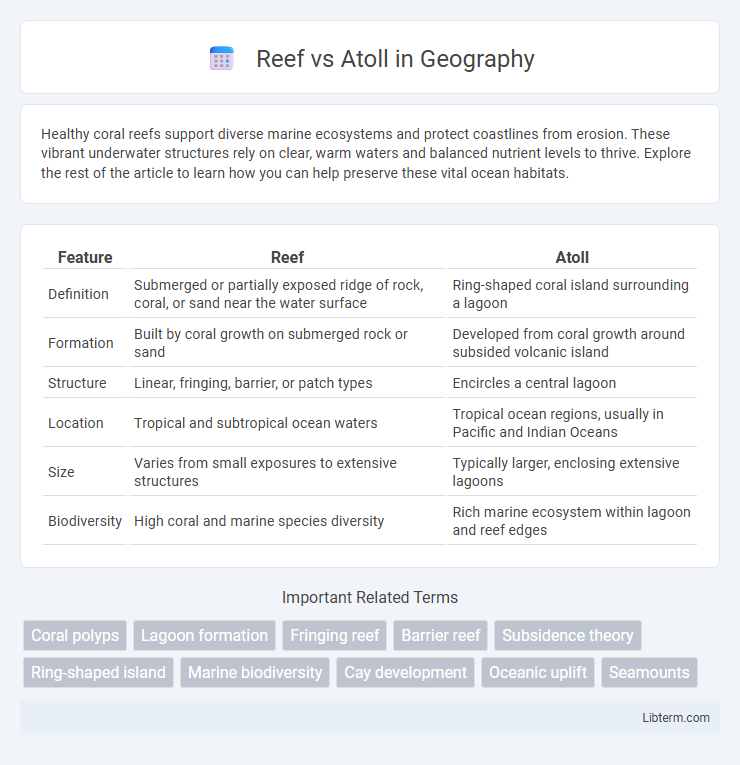Healthy coral reefs support diverse marine ecosystems and protect coastlines from erosion. These vibrant underwater structures rely on clear, warm waters and balanced nutrient levels to thrive. Explore the rest of the article to learn how you can help preserve these vital ocean habitats.
Table of Comparison
| Feature | Reef | Atoll |
|---|---|---|
| Definition | Submerged or partially exposed ridge of rock, coral, or sand near the water surface | Ring-shaped coral island surrounding a lagoon |
| Formation | Built by coral growth on submerged rock or sand | Developed from coral growth around subsided volcanic island |
| Structure | Linear, fringing, barrier, or patch types | Encircles a central lagoon |
| Location | Tropical and subtropical ocean waters | Tropical ocean regions, usually in Pacific and Indian Oceans |
| Size | Varies from small exposures to extensive structures | Typically larger, enclosing extensive lagoons |
| Biodiversity | High coral and marine species diversity | Rich marine ecosystem within lagoon and reef edges |
Introduction to Reefs and Atolls
Reefs are diverse underwater ecosystems primarily composed of coral skeletons that provide habitat for marine life, often found in shallow, warm ocean waters. Atolls are ring-shaped coral reefs that encircle a lagoon, formed from the subsidence of volcanic islands and subsequent coral growth. Both reefs and atolls play crucial roles in coastal protection, biodiversity support, and marine resource sustainability.
Definition of Reefs
Reefs are underwater structures composed primarily of coral, rock, or other marine organisms that provide habitat for diverse marine life and help protect coastlines from erosion. Unlike atolls, which are ring-shaped coral islands surrounding a lagoon, reefs can take various forms including fringing reefs, barrier reefs, and patch reefs based on their location and formation. These biologically rich ecosystems play a crucial role in maintaining oceanic biodiversity and supporting fisheries.
Definition of Atolls
Atolls are ring-shaped coral reefs that encircle a lagoon either partially or completely, formed from the gradual subsidence of volcanic islands combined with coral growth. Unlike general reefs, atolls exhibit a distinctive circular structure with a central lagoon, often hosting diverse marine ecosystems. The key characteristic of atolls is their development from sinking volcanic islands, which differentiates them from typical barrier or fringing reefs.
Formation Processes of Reefs
Reefs primarily form through the accumulation of calcium carbonate from coral polyps and other marine organisms, developing in shallow, warm ocean waters. Atolls originate from volcanic island subsidence, where coral growth continues upward as the island sinks, creating a ring-shaped reef enclosing a lagoon. The dynamic balance between coral growth and sea level changes governs the morphology of both reefs and atolls.
Formation Processes of Atolls
Atolls form through the gradual subsidence of volcanic islands combined with the upward growth of coral reefs, creating a ring-shaped coral reef surrounding a central lagoon. The process begins with fringing reefs developing around a volcanic island, which then becomes a barrier reef as the island slowly sinks, and eventually leads to the formation of an atoll when the island is completely submerged. This unique formation emphasizes coral growth outpacing the sinking landmass, distinguishing atolls from simple coral reefs that form on stable substrates.
Key Differences Between Reefs and Atolls
Reefs are underwater structures primarily made of coral, rock, or sand, providing habitats for diverse marine life, while atolls are ring-shaped coral islands encircling a lagoon, formed from the sinking of volcanic islands. The key difference lies in their formation process: reefs develop on submerged surfaces or along coastlines, whereas atolls form when coral growth keeps pace with the subsidence of an island, creating a lagoon surrounded by coral. Reefs can exist in various shapes including fringing, barrier, and patch reefs, but atolls are distinctly characterized by their lagoon-centered coral ring structure.
Ecological Importance of Reefs and Atolls
Reefs and atolls provide critical habitats for diverse marine species, supporting high biodiversity and complex ecosystems. These structures act as natural barriers, protecting coastal areas from erosion, storm surges, and rising sea levels, thereby safeguarding human communities and shorelines. Their ecological importance is also linked to nutrient cycling and carbon sequestration, contributing to global environmental stability and marine productivity.
Geographic Distribution
Reefs are commonly found in tropical and subtropical ocean waters, especially along continental shelves and around islands where conditions support coral growth. Atolls are predominantly located in the Pacific and Indian Oceans, forming ring-shaped coral islands surrounding a central lagoon, often remnants of submerged volcanic islands. The geographic distribution of atolls is closely linked to tectonic activity and sea-level changes in these warm, low-latitude ocean regions.
Common Examples of Reefs and Atolls
The Great Barrier Reef in Australia is one of the most extensive coral reef systems globally, showcasing diverse marine habitats and vibrant coral formations. Atolls such as the Maldives and Bikini Atoll feature ring-shaped coral reefs surrounding central lagoons, formed by the subsidence of volcanic islands. Both reefs and atolls serve as critical ecosystems supporting rich biodiversity and protecting coastal regions from erosion.
Conservation Challenges and Future Outlook
Reefs face significant conservation challenges from climate change, coral bleaching, pollution, and overfishing, threatening their biodiversity and structural integrity. Atolls, often dependent on reef-building corals, suffer from rising sea levels and increased ocean acidity, complicating conservation efforts and threatening island ecosystems and human communities. Future outlook demands integrated management strategies combining marine protected areas, sustainable fishing practices, and global efforts to reduce greenhouse gas emissions to preserve these critical marine habitats.
Reef Infographic

 libterm.com
libterm.com